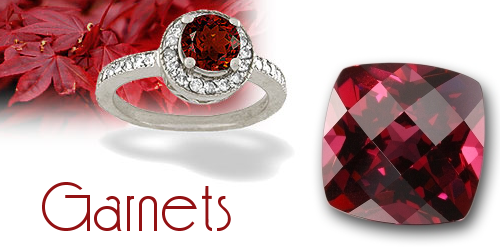 Buttons // Join // Edit // Fans // Garnets // Links // Clear
Buttons // Join // Edit // Fans // Garnets // Links // Clear

Garnets Aren't garnets those wonderful deep-red gemstones you often find in antique jewellery? Well yes, to a certain extent, a deep, warm red indeed being the colour most frequently found in garnets. Sadly, however, far too few people are aware that the world of the garnets is far more colourful than that. Spectacular finds, especially in Africa, have enhanced the traditional image of the garnet with a surprising number of hues - even if red does continue to be its principal colour. Thanks to their rich colour spectrum, garnets today can quite happily keep pace with changes of style and the colour trends of fashion. And thanks to the new finds, there is a reliable supply of them too. So in fact this gemstone group in particular is one which gives new impetus to the world of jewellery today.
By the term 'garnet', the specialist understands a group of more than ten different gemstones of similar chemical composition. It is true to say that red is the colour most often encountered, but the garnet also exists in various shades of green, a tender to intense yellow, a fiery orange and some fine earth-coloured nuances. The only colour it cannot offer is blue*. Garnets are much sought-after and much worked gemstones - the more so because today it is not only the classical gemstone colours red and green which are so highly esteemed, but also the fine hues in between. Furthermore, the world of the garnets is also rich in rarities such as star garnets and stones whose colour changes depending on whether they are seen in daylight or artificial light.
And what else is there that distinguishes this gemstone group from the others? Well, first of all there is its good hardness of 7 to 7.5 on the Mohs scale. With a few minor exceptions it applies to all the members of the garnet group, and it is the reason for the excellent wearing qualities of these gemstones. Garnets are relatively insensitive and uncomplicated to work with. The only thing they really don't like is being knocked about or subjected to improper heat treatment. A further plus is their high refractive index, the cause of the garnet's great brilliance. The shape of the raw crystals is also interesting. Garnet means something like 'the grainy one', coming from the Latin 'granum', for grain. This makes reference not only to the typical roundish shape of the crystals, but also to the colour of the red garnet, which often puts one in mind of the seeds of a ripe pomegranate. In the Middle Ages, the red garnet was also called the 'carbuncle stone'. And even today, fantasy names like Arizona ruby, Arizona spinel, Montana ruby or New Mexico ruby are still rife in the trade. (more...)
- gemstone.org
© This site is a fan effort of 10-31.net. No copyright infringement is intended.

| 


